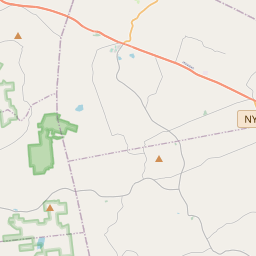Catherine Merckley
Historical marker location:
Janesville, New York
( Marker is on New York State Route 10 south of Bush Street, on the right when traveling south.)
Marker installed: 1927







© OpenStreetMap contributors
The first American museum was founded in New York City in 1792. It was called the American Museum, and it was located in what is now City Hall Park.
About Schoharie County
Schoharie County Timeline
Schoharie County, located in upstate New York, has a rich and varied history that stretches back centuries. Native American tribes, including the Mohawk and Mohican, inhabited the region before European settlement. In 1712, a group of Palatine Germans arrived in Schoharie Valley, seeking refuge from political and religious turmoil in Europe. They established settlements and helped shape the future of the county.
During the American Revolutionary War, Schoharie County played a significant role. The area was strategically important due to its agricultural abundance. The British sought to disrupt the local food supply, leading to a series of fierce engagements known as the Schoharie Campaign. Despite destructive raids by British-aligned forces, the settlers managed to defend their homes and farms.
In the 19th century, Schoharie County experienced significant growth and development. The Erie Canal, completed in 1825, opened up new opportunities for trade and transportation. The county's fertile soil contributed to the growth of agriculture, including dairy farming and apple orchards. The construction of railroads further improved connections to other parts of the state.
In the 20th century, Schoharie County faced challenges and changes. The Great Depression impacted the local economy, but efforts to diversify industries, such as tourism and manufacturing, helped mitigate the effects. The county also saw population shifts as younger generations moved to urban areas for better opportunities. Today, Schoharie County continues to thrive as a rural community, preserving its historical charm while adapting to modern needs.
During the American Revolutionary War, Schoharie County played a significant role. The area was strategically important due to its agricultural abundance. The British sought to disrupt the local food supply, leading to a series of fierce engagements known as the Schoharie Campaign. Despite destructive raids by British-aligned forces, the settlers managed to defend their homes and farms.
In the 19th century, Schoharie County experienced significant growth and development. The Erie Canal, completed in 1825, opened up new opportunities for trade and transportation. The county's fertile soil contributed to the growth of agriculture, including dairy farming and apple orchards. The construction of railroads further improved connections to other parts of the state.
In the 20th century, Schoharie County faced challenges and changes. The Great Depression impacted the local economy, but efforts to diversify industries, such as tourism and manufacturing, helped mitigate the effects. The county also saw population shifts as younger generations moved to urban areas for better opportunities. Today, Schoharie County continues to thrive as a rural community, preserving its historical charm while adapting to modern needs.
Schoharie County Timeline
This timeline provides a concise overview of the key events in the history of Schoharie County, New York.
- 1609 - Henry Hudson explores the area, including what is now Schoharie County, during his exploration of the Hudson River.
- Mid-1600s - Dutch settlers begin to establish farms and settlements in the Schoharie Valley.
- 1713 - Schoharie becomes the official name for the area, derived from the Mohawk word "eskahr," meaning driftwood.
- 1755 - During the French and Indian War, the Schoharie Valley is targeted by Native American allies of the French, resulting in the construction of fortified German Palatine settlements.
- 1776 - Schoharie County is established as part of Albany County, amidst the American Revolutionary War.
- 1795 - Schoharie County becomes its own separate county in New York State.
- 1800-1850 - The construction of the Erie Canal brings economic growth to Schoharie County, as it becomes a key transportation route.
- Mid-1800s - The Schoharie County Fair is established, becoming an annual event celebrating agriculture and local traditions.
- Late 1800s - Schoharie County experiences an agricultural boom with the introduction of dairy farming and increased production of hops.
- Early 1900s - The decline of hops production and the effects of the Great Depression affect the county's economy.
- Mid-1900s - Schoharie County attracts tourists with its natural beauty and outdoor recreational opportunities.
- 1998 - Schoharie County is severely impacted by flooding caused by Hurricane Floyd.
- 2011 - Schoharie County suffers extensive damage due to flooding caused by Tropical Storm Irene.